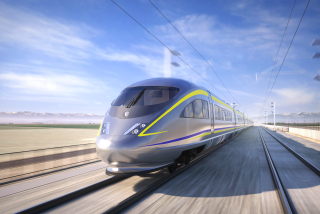California state panel defends ridership and revenue estimates for high-speed rail project
The state panel charged with building California’s 800-mile bullet train network pushed back Thursday against an academic analysis challenging the reliability of ridership and revenue estimates underpinning the massive project.
The UC Berkeley-based Institute of Transportation Studies last week reported that patronage models for the $42-billion first phase were too flawed to accurately predict whether the trains would run severe deficits or generate large operating surpluses, as planners predict. The review was requested by the chairman of a state Senate oversight panel.
At a downtown Los Angeles meeting Thursday of California High-Speed Rail Authority directors, experts sparred over highly technical ridership projection questions with serious implications for the state’s largest public works project in recent history.
Authority officials and consultants portrayed their estimates, which generally have shown tens of millions of annual riders and profits likely to attract major private investors, as state-of-the-art and realistic.
Lance A. Neumann, president of Cambridge Systematics, which developed the agency’s projections, said they incorporated solid science and the practical needs of the agency.
“You can always use more data. You can always use more model refinement,” he said. “The challenge is to develop a workable tool within budget and schedule constraints that gives you credible information to base decisions on.”
One of the authors of the critical review acknowledged that the agency’s patronage projections followed standards widely used in the transportation industry. He suggested that was part of the problem, that many such studies aren’t reliable.
“It’s caused, I think, a lot of problems when it turns out later on the actual ridership is way off from the forecasts,” said UC Irvine professor David Brownstone. “This is a problem with almost all existing work.” He called on the board to “go beyond standard practice … and do it right,” particularly given the project’s massive public investment.
Among other things, Brownstone and his colleagues challenged traveler sampling procedures used in the projections and criticized the failure to include a potential error range in the estimates. Neumann said the sampling was proper and he firmly stands behind the projections “without reservation.”
Ridership projections will be refined, agency officials have said, as routing, station location, ticket pricing and other decisions are made. One potential partner, the French high-speed rail developer SNCF, remains bullish on the project. The firm strongly believes California high-speed rail can be profitable, Denis A. Doute, chief executive officer of SNCF America, told the board.
Also on Thursday, the rail board formally agreed to revive a construction option that would share track with other passenger rail systems between Los Angeles and Anaheim, the first segment expected to be built. If ultimately chosen, this option could greatly reduce the need to purchase and demolish businesses and residences along a corridor cutting through the region’s core.
Cities along the route support the shared-track alternative, but remain concerned about the agency’s planning process.
A push to break ground in 2012 to secure $2.25 billion in federal stimulus funding could compromise evaluations of community impacts and other possible routes, Santa Fe Springs City Manager Frederick W. Latham warned the board. “This rush to judgment is becoming increasingly apparent,” he said.
More to Read
Sign up for Essential California
The most important California stories and recommendations in your inbox every morning.
You may occasionally receive promotional content from the Los Angeles Times.









